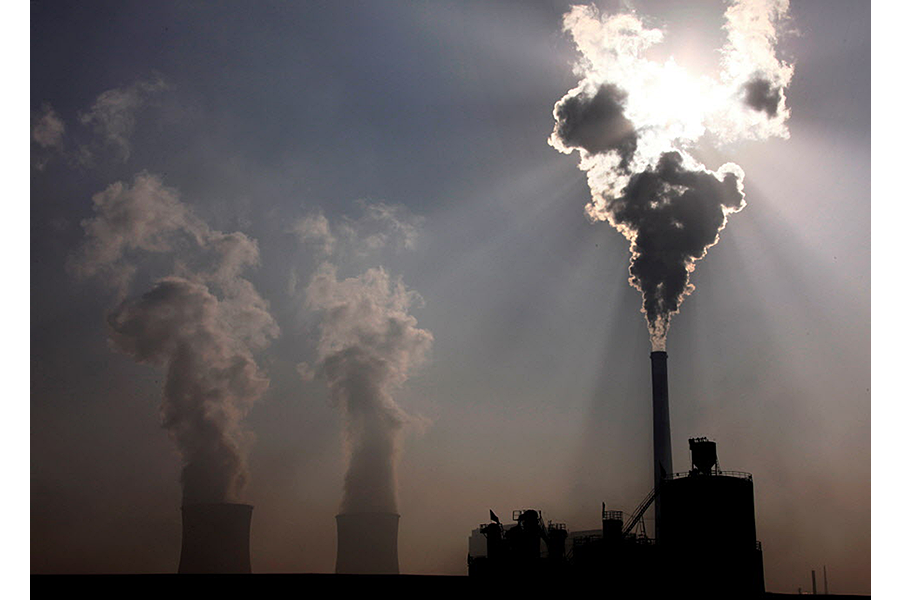How natural gas and nuclear have made the US greener – times two
Loading...
Two-thirds of US states saw their economies grow while they reduced their carbon-dioxide emissions from 2000 to 2014. They did this by relying more on natural gas and nuclear energy for electricity production and less on coal, according to a report published Thursday by the Brookings Institution.
Thirty-three states, primarily in the Northeast and South, as well as the District of Columbia, reduced their carbon emissions while they grew their gross-domestic products (GDP) during those years, a term known as “decoupling.” Many Northeastern states reduced their carbon emissions by increasing the amount of electricity they generate from natural gas, while parts of the South did so, in part, because they rely on nuclear energy.
Several analyses from earlier this year already found dozens of countries decoupled, a feat once thought near impossible because renewable energies were thought to hurt economic growth. In fact, the World Resources Institute (WRI) found in April that the United States is the largest country to experience multiple consecutive years of decoupling. But the study by the Brooking Institution’s Metropolitan Policy Program is the first of its kind to examine this trend state-by-state.
The study also comes as the world’s nations are poised to experience a shift in how they power their economies and lives, although the direction now remains unclear. In addition to 2015 being the first year in a decade with flat global carbon emissions, it also saw the passage of the Paris climate agreement. But President-elect Donald Trump could reverse this momentum. During his campaign, he promised to revive the coal industry, and tear up environmental regulations that he says hurt the economy.
But the study’s authors and some environmental researchers say it plots a model for other states and countries to look to, and suggests this trend will continue with or without Washington’s help.
“The focus of action is actually going to depend more and more on the states now,” says Devashree Saha, who is one of the study's authors, and an associate fellow at Brookings. “States have to take on more and more responsibility to keep the momentum going, especially in an era of federal drift and retreat.”
“It is not an impossible scenario,” she adds in a Wednesday phone interview with The Christian Science Monitor. “Historically, we have seen that a lot of energy innovation has actually happened at the state level,” including clean energy funds, Renewable Portfolio Standards, clean-energy finance banks, and policies such as carbon-emission targets and renewable energy standards. “More and more the states have to step up and keep this momentum.”
In the study, Dr. Saha and Mark Muro, a senior fellow at Brookings, compared the GDP growth of all 50 states and D.C. to data on energy-related carbon dioxide emissions from 2000 to 2014.
While multiple factors have influenced the pace of decoupling, “some of the most important factors are market trends and the shifting nature of state economies,” the report notes.
The difference among states, Saha tells the Monitor, partly boils down to how they generate electricity. The Northeast and South achieved decoupling through natural gas and nuclear energy. In Massachusetts, for instance, electricity production from natural gas increased 32 percent, from 28 percent in 2000 to 60 percent in 2014. In Tennessee, where two nuclear facilities account for more than a third of electricity generation, carbon emissions were reduced by 19 percent, while the state's economy expanded by 23 percent. Much of the Midwest and West went the other way, however.
Sixteen states saw their carbon emissions rise with their economies, in part because they rely on coal to produce electricity. Nebraska saw its carbon emissions increase by 26 percent, while North Dakota saw its carbon emissions increase by 16 percent.
The report adds to several analyses of global carbon emissions. In March, the International Energy Agency in Paris found carbon emissions from the energy sector stayed flat for the past two years even as the global economy grew by more than 3 percent. In April, WRI found 21 countries have achieved decoupling since 2000, although they noted this trend occurred for a variety of reasons, from carbon taxes in Sweden to an increase in renewable energies in Denmark.
While environmental researchers welcomed the Brookings study, they also wondered about so-called “carbon leakage,” in which a country, state, or city sees many of its industries move to places with lesser or no curbs on greenhouse gases.
Aseem Prakash, founding director of the University of Washington’s Center for Environmental Politics, noted in an email to the Monitor that the study acknowledges carbon leakage in Northeastern states that have been importing more hydroelectric power from Canada, in addition to generating more electricity from natural gas.
Ari Peskoe, a senior fellow in electricity law at Harvard Law School, tells the Monitor in an email that state policy has been a major driver in the growth of renewable energy. He cites the Lawrence Berkeley National Lab, which found that more than half of all growth in renewable electricity generation since 2000 is associated with state's Renewable Portfolio Standards requirements. But federal policies, he added, such as renewable energy tax credits, appliance efficiency standards, and Environmental Protection Agency regulations, probably contributed to reductions in carbon dioxide emissions, as well. [Editor's note: This paragraph has been updated from the original version.]
But Nate Aden, a research fellow at WRI and a doctoral candidate at the Energy and Resources Group at the University of California at Berkeley, said the Brookings study shows the US economy is transforming regardless of campaign and populous rhetoric.
“This is a snapshot of past 15 years,” he says. “Things are changing quickly right now regardless of the election.”







